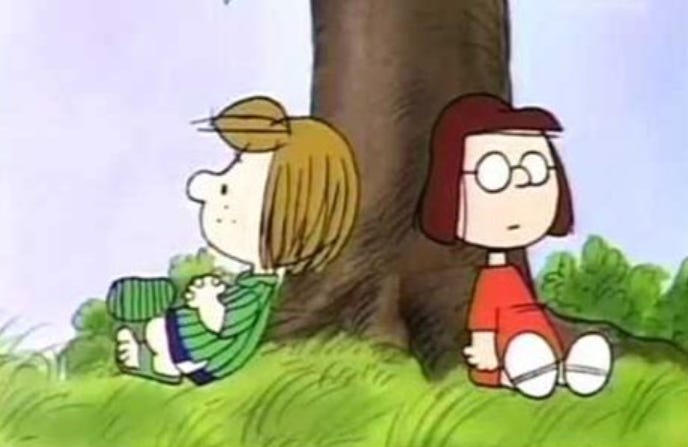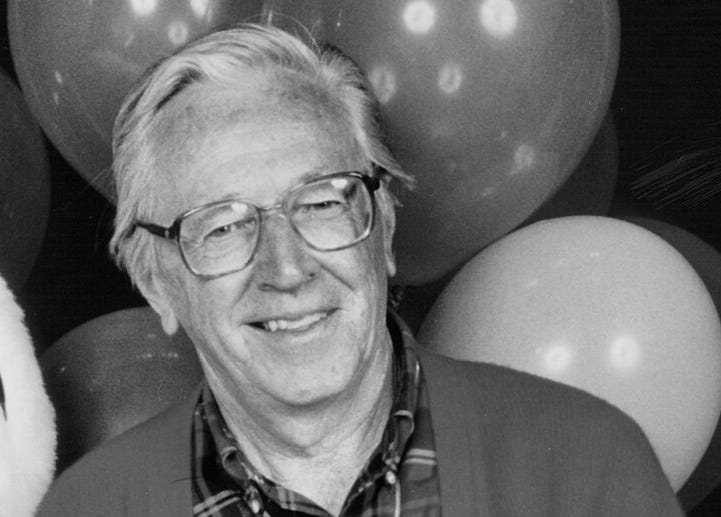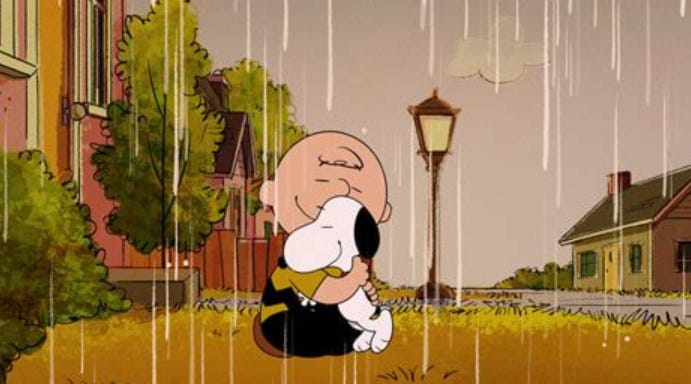Should Charlie Brown Have Been Allowed to Finally Kick the Football?
What I've decided living in a land of ancient wisdom.
My husband Michael and I are currently living in East Asia — specifically, Taipei, Taiwan.
This region of the world is renowned for being a place of ancient wisdom, and sure enough, I find my thoughts turning to one of the most profound and difficult philosophical questions of all time:
Should Charlie Brown have been allowed to finally kick the football?
Charlie Brown is, of course, the main character in the classic comic strip Peanuts by Charles M. Schulz.
And almost every autumn for the 50-year run of the strip, from 1950 to 2000, Schulz would draw a full Sunday comic in which another character, Lucy, would promise to hold a football for Charlie Brown so he could run and kick it.
But every year, Lucy would pull the football away at the last second, and poor Charlie Brown would go flying and land on his back.
Why have I been pondering this whole “football” question now, here in Taipei?
To my surprise, Peanuts is still weirdly popular in Taiwan — especially Snoopy, who has become something of a national icon. A week ago, in one of the nearby malls, we passed a well-attended exhibition of Peanuts memorabilia. There are also Peanuts-themed restaurants, and it’s very common to see Peanuts merchandise in stores.
What’s behind the popularity?
It’s probably nostalgia, and maybe also the comic strip’s themes of decency and perseverance resonating with the local culture.
But I’m truly not kidding when I say I think the question of whether Charles Schulz should’ve finally let Charlie Brown kick the football is a legitimately profound one.
These days, most people know about Charlie Brown from the animated movies and TV specials, especially three holiday-themed ones: A Charlie Brown Christmas, It’s the Great Pumpkin, Charlie Brown, and A Charlie Brown Thanksgiving.
These projects are good — especially A Charlie Brown Christmas — but they don’t capture what made the original comic strip so great, especially in its artistic peak from about 1958 to 1972.
Schulz’s characters were young children — after 1955, adults famously never appeared in the strip. They’re unseen in the animated specials too, and if they speak, we only hear trombones.
And yet, the humor and themes in the strip are anything but juvenile. Charlie Brown is a hapless, anxious loser, and the other kids are often openly cruel, especially Lucy.
But nothing about the strip or its characters is what you’d expect — not that the neighborhood bully is a girl, or that the strip’s other major female character is Peppermint Patty, the best athlete in town.
Even Lucy isn’t wholly bad because the characters are complex, and the themes are often insanely sophisticated.
Peppermint Patty — who has a reputation these days as a “baby dyke” because she’s such a great athlete — is deeply in love with Charlie Brown, as is her best friend, Marcy. But he’s famously in love with the Little Red-Haired Girl (also unseen, at least in the strip).
Meanwhile, Lucy loves Schroeder, who completely ignores her because he’s obsessed with the composer Beethoven. (Tortured-artist Schroeder is the strip’s actual coded gay character.)
And Sally loves Linus, who only has eyes for his teacher, Miss Othmar — and also the Great Pumpkin, a “Godot”-like character who Linus patiently waits for every year in a pumpkin patch but who never actually shows up.
Literally every character is in love with someone who doesn’t love them back! And they’re all frequently disappointed and miserable, endlessly yearning for something they can never have.
And yet, this existential hell of a comic strip also has a reputation as family-friendly, and appeals to young children, probably because of the inclusion of Charlie Brown’s happy-go-lucky dog, Snoopy.
Whimsical Snoopy was the spoonful of sugar that allowed the bitter medicine of the rest of the strip to go down — and arguably also led to the strip’s artistic decline, when it became more Snoopy-focused (and much more anodyne) from the mid-70s onward.
Honestly, part of me wonders if Snoopy’s “cuteness” is the real reason why the Taiwanese are obsessed with Peanuts. Like Japan and South Korea, which also love Peanuts, they adore cute characters here.
But this brings me back to Lucy repeatedly yanking that football away from Charlie Brown.
Over the decades, Lucy offered all kinds of different explanations for why she does it.
One year, she shakes hands on her promise not to pull the football away, only to later point out, “A woman’s handshake is not legally binding” — which was true in 1963, when the strip first ran.
Another year, she has a muscle spasm — a “ten billion to one” chance.
One year, in a fantastic feminist joke, she openly admits she’s going to pull the football away, and Charlie Brown runs for it anyway, with Lucy later saying, “Men never really listen to what women are saying, do they?”
And in 1979, after making a sacred vow to not pull the football away if Charlie Brown survives an illness, Lucy finally really doesn’t pull it away — but being the loser he is, Charlie Brown misses the ball and kicks Lucy.
Honestly, she kinda deserves it.
Or does she? In 1953, before the strip had evolved into its modern incarnation (and Lucy is younger — the neighborhood pest), Charlie Brown mocks Lucy on the football field, saying, “Little girls don’t belong on football fields! Go home!”
In short, maybe Lucy spent almost the next fifty years getting a kind of karmic retribution.
The more interesting question is: what does it all mean?
In 1993, on a freelance assignment for the Los Angeles Times, I got to interview Charles Schulz. I called up his office, intending to schedule a future interview, but before I could finish speaking, his assistant said, “He’d be happy to talk to you right now” — and immediately patched me through to his art studio, despite my having prepared absolutely nothing.
Schulz had long been one of my idols, and I was finally getting a chance to talk to him, and here I was, completely unprepared, babbling like a total idiot.
But as I stammered my way through the interview, I quickly learned that the man took his strip extremely seriously.
“I know some people say my strip isn’t as good as it once was,” he told me. “But I think the work I’m doing right now is as good as anything I’ve ever done!”
At the same time, he was fairly cagey about claiming greater meanings, arguing that cartoonists shouldn’t take themselves too seriously.
But there’s a reason why Peanuts is the most successful comic strip of all time — and why so many concepts and images from the strip have entered the vernacular, like Linus and his security blanket, the Kite-Eating Tree, and the Great Pumpkin.
And, yes, Lucy and the football.
Snoopy gave the strip its light, but almost everything else in the strip was about darkness — frustration and defeat.
Even Snoopy had an unending string of disappointments — losing out on love with another dog, mourning his first owner who was forced to give him up (and is later hospitalized (!!!) due to some unnamed illness), his doghouse burning down (and his “Andrew Wyeth” painting destroyed), and on and on.
According to Schulz, life was mostly failure and disappointment.
In fact, the darkest moment in the entire comic may have come in one of these “football” strips. As Lucy holds the football, Charlie Brown wonders how long he’ll have to put up with this annual humiliation, even quoting scripture, saying, “How long, O Lord?”
And after she pulls the football away one more time, Lucy coldly answers: “How long? All your life, Charlie Brown. All your life.”
Keep in mind: this was supposedly a comic strip for and about little kids!
But scenes like this, of ritualized humiliation, were only one half of the genius of Charles Schulz.
The other half was that even in the face of all these failures and disappointments, none of the characters ever gave up. They never lost their faith that things might one day somehow get better.
Schulz talked about this too, with me and other interviewers.
"Charlie Brown will always keep hoping,” he said in 1967.
For most of his life, Schulz was emphatic that Charlie Brown never get to kick the football — that this was the whole point of the strip.
“Oh, no, definitely not,” he said in 1999, the year before he died. “I couldn’t have Charlie Brown kick that football. That would be a terrible disservice to him after nearly half a century.”
But in one of his last interviews, Schulz admitted he was in tears when he signed his final strip: “All of a sudden I thought, ‘You know, that poor, poor kid, he never even got to kick the football. What a dirty trick — he never had a chance to kick the football.”’
Schulz died the day that final strip ran.
So what’s the answer? Should Charlie Brown have been allowed to finally kick the football?
In the end, I think the answer depends on what you think is the nature of “life.”
Incidentally, have I convinced you that this really is one of the most profound and difficult philosophical questions of all time?
On one hand, some say that life is a tragedy — a sad story where the protagonist ultimately fails. And yeah, no matter what we do, we’re all going to die in the end. At best, we can honestly accept and admit our defeat.
If that’s your take, Charlie Brown can’t kick the football. It’s un-kickable.
This was definitely my take after graduating from university in my early twenties.
On the other hand, some think life can be a comedy — a happy story where the protagonist ultimately succeeds. Sure, we all die in the end, but by never giving up — and, perhaps, by living a life of love and laughter — we can achieve a kind of “victory” even in the face of death.
Failure or success don’t matter. What matters is our attitude in the face of it all.
Those who say that life is a tragedy would argue that this is just a pathetic rationalization.
But increasingly, this second take is what I believe.
Peanuts straddled the line between tragedy and comedy — between Charlie Brown and Snoopy.
But in the end, I think even Schulz would say the comedy won out. It was a comic strip, after all.
Charlie Brown never gave up.
And if that’s the case, it really doesn’t matter if he never kicked that damn football, does it?
Brent Hartinger is a screenwriter and author. Check out my other newsletter about my travels at BrentAndMichaelAreGoingPlaces.com. And order my latest book, below.









This is one of my favorites of all the pieces you’ve shared.
If he had kicked the ball, this is how it would've gone down:
Linus: So you finally kicked the football, Charlie Brown.
Charlie: Yes. But to tell you the truth, Linus, it wasn't as much fun as I thought it was going to be. I'm still depressed about Christmas coming.
It was really only as an adult that I fully appreciated the delightful weirdness of the Peanuts universe, *especially* the Great Pumpkin (where did the idea of a "sincere pumpkin patch" even come from?). You have a dog who fantasizes about being a WW1 flying ace (something most kids don't even have a clue about; I sure didn't); a little girl who runs not a lemonade stand but a psychiatric stand (!) which the local kids actually patronize (!); a sadistic neighborhood where all the adults apparently see nothing wrong with filling a little kid's Halloween bag with rocks; a boy who is always referred to by both his first and last names, even by his best friend; a girl who thinks "naturally curly hair" is just the greatest achievement ever ... it's so funny that Peanuts is generally seen as a kind of cuddly, mild, cute comic when, as you have pointed out, a lot more is going on!